Menus
- First and last
- 2.163 cc V-Twin, 156 hp and 217 Nm, 247 kg full made, $ 75,000
- Discovery
- In the saddle
- Test
- Cycle part
- Braking
- Conclusion
First and last
2.163 cc V-Twin, 156 hp and 217 Nm, 247 kg full made, $ 75,000
Curtiss Motorcycle Co., named after legendary American biker and aviation pioneer Glenn H. Curtiss, is one of the most historic names in the pantheon of American motorcycle brands. Curtiss virtually invented the V-Twin motorcycle, along with Eclipse in Great Britain and NSU in Germany to produce the first two-wheeler of this type in 1903 under the Hercules brand, changed in 1904 to Curtiss. It was the first copy built of what would become the iconic American V-Twin, followed by Indian in 1905 and then Harley-Davidson in 1909.
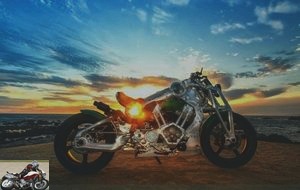 Curtiss P40 Warhawk Final Edition review
Curtiss P40 Warhawk Final Edition review
Curtiss was an engineering visionary as well as a brave man whose most notable achievement on two wheels was to set a speed record of 219.45 km / h in January 1907 in Ormond Beach, Florida, on a 4.410cc V8 motorbike developing 40 horsepower that he himself had imagined and built, before moving on to planes and following the exploits of the Wright brothers. In the meantime, his motorcycle speed record will hold 23 years before being broken !
After more than a century in limbo, the Curtiss Motorcycle Company was relaunched in 2018 with the renaming of the Birmingham, Alabama-based Confederate Motors brand. After practicing the Art of Rebellion for a quarter of a century in the production of 1,300 American maxi-cruisers without the slightest compromise and incredibly unconventional since its inception in New Orleans in 1992 by former lawyer H. Matthew Chambers , Confederate designed its latest motorcycle, marking the end of a period of iconoclastic innovation that began on November 11, 1994 with the release of the first Hellcat from the Louisiana plant. This literally unique motorcycle maker not only adopted the Curtiss name, but also ditched the use of internal combustion engines to focus 100% on producing an eclectic line of electric motorcycles. The first of them, the Curtiss Hades designed by JT Nesbit (creator of the Confederate Wraith and the latest Hellcat series) will be unveiled in June at the Glenn Curtiss Museum in his hometown of Hammondsport, New York, with deliveries scheduled. by the end of 2020.
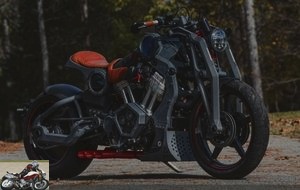 The Confederate FA-13 Combat Bomber
The Confederate FA-13 Combat Bomber
So goodbye Confederate and hello Curtiss. But the Art of Rebellion is not forgotten, not quite. To bridge the delays between the productions of these two brands (as well as to keep the mechanics and assemblers working while the R&D team completes the development of the Hades), Chambers celebrated the return of the Curtiss brand with a final farewell to the type of motorcycles built in 25 years with the Curtiss P40 Warhawk.
The Curtiss P40 Warhawk, takes its name from a WWII military aircraft, like all Chambers products. It looks like a one-off model, but 13 copies have been produced in two years. It must be said that at 105,000 $ each (around 95,900 €), the motorcycle is reserved for a small handful of bikers. There are still seven copies to come, which will be assembled in the Birmingham factory, for a "Final Edition" series not for a higher price but for a more "accessible" price of $ 75,000 (around € 68,500)..
Matt Chambers, CEO of Curtiss Motorcycles:
After that, we will no longer produce any motorcycles that require a spark to ignite the engine. Our factory will be entirely dedicated to the manufacture of electric models.
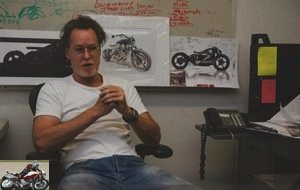 Matt Chambers, CEO of Curtiss Motorcycles
Matt Chambers, CEO of Curtiss Motorcycles
Discovery
The Curtiss Warhawk uses the same design design as the latest Confederate motorcycle series. Here again, we are talking about a small series with only 13 units for the FA-13 Bomber Combat, produced between 2016 and 2018 and sold for $ 155,000 (around € 141,500). But for that price, we had a custom-made leather jacket made from the same leather as the bike saddle. !
Obviously, the Curtiss Warhawk Final Edition being less expensive does not benefit from this detail. What is certain is that this is both the first Curtiss V-Twin motorcycle built in over a century and the last of its kind. Afterwards, it will only be Electric Hades in the Curtiss catalog.
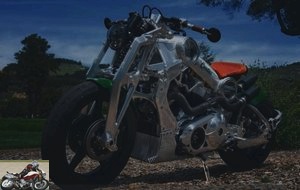 The Curtiss P40 Warhawk Final Edition
The Curtiss P40 Warhawk Final Edition
Its Bomber base means the Warhawk is built around the same 178mm diameter fuselage that forms the backbone of the frame with components machined from 6061-T6 aluminum and bolted together to create a unibody chassis around the V-Twin engine. mounted as a pressure element. It is a true monohull because it also includes the 16 liter fuel tank in a tank inside the fuselage and which extends downward from the saddle..
There are then five "openings" in the chassis: the upper trio allows you to see into the airbox integrated in the upper section while the lower pair allows you to monitor the fuel level. Imagine the legendary monocoque chassis of the Norton John Player victorious in the Tourist Trophy, but in machined aluminum and bolted rather than welded as on the old English. That’s what the Warhawk stands for, although it sports a much different OHV twin than the Nortons, with a 75hp 750cc parallel engine..
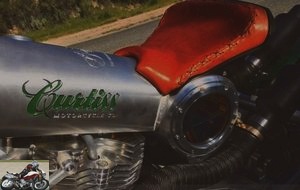 The monocoque frame shows the fuel level
The monocoque frame shows the fuel level
As with recent Confederate models, the Warhawk is powered by a 2,163cc air / oil-cooled S&S X-Wedge 56.25 ° V-twin engine with triple camshaft with two valves per cylinder and a forged crankshaft. one piece. The engine architecture was specifically designed for this bike by the Wisconsin company with housings also sculpted from 6061 aluminum and with dedicated mounting points to fit the Warhawk’s unibody frame design. This powertrain also incorporates the five-speed Andrews gearbox, a format the company first used in 1995, two years before Yamaha did so on the R1. This is mounted in a fully machined transmission case and bolted directly to the X-Wedge engine to create a true unit. The short 44mm belt primary drive is mounted on the left, combined with a Bandit dry multi-plate clutch and with a chain final drive on the right. The chain was preferred to the belt because of the very high torque. Indeed, the engine has been tuned specifically for the Warhawk to deliver plenty of horsepower and character in a fully road-approved and subtly overhauled package. According to Chambers, the engine is slightly more efficient than before.
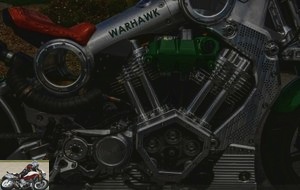 The V-Twin S&S X-Wedger cube а 2.163 cm3
The V-Twin S&S X-Wedger cube а 2.163 cm3
It is the ultimate high performance V-Twin motorcycle, just as it is the first and last machine to bear Mr Curtiss’ name for the first time in 110 years. We have gained six horsepower on this engine which runs even harder than before and which is now capable of reaching 6,200 rpm, which is 200 more revs. This is because we have a new camshaft design which improves performance, at the same time we keep the same high level of torque as before, still very low. So we have more in our hands, without losing on either plan.
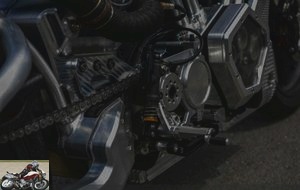 The final transmission is by chain
The final transmission is by chain
So the 156 horsepower at 5,500 rpm produced at the rear wheel by the Warhawk’s X-Wedge engine is 4% higher than on the Bomber, not to mention the same torque of 217 Nm at just 2,000 rpm. The American Muscle Bike era may be coming to an end, but these bikes won’t be forgotten, especially not by someone who was lucky enough to ride one..
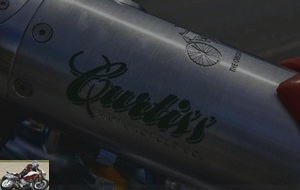 New logo features Alabama builder’s frames
New logo features Alabama builder’s frames
The final edition of the Warhawk was also architecturally overhauled. Curtiss designer Jordan Cornille has improved the overall appearance, with smoother stainless steel Burns exhausts (and which are also partly responsible for the few horsepower gained). These work their way back to the inside of the legs. They are thankfully wrapped in heat-insulating tape (well, partially), before concluding with a pair of ultimately very anonymous mufflers, sorry Matt, but they just look cheap and contrast with the rest just like the rims. magnificent.
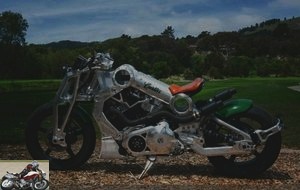 The exhaust has been returned to the high position
The exhaust has been returned to the high position
Yes, we need a better muffler, they are not very good looking, are they? But they sound so good, with an angry side in the exhaust note. Function beats form, I’m afraid !
Underneath the S&S dry-sump engine, instead of the exhausts, there is a larger oil reservoir that not only holds 1.4 liters of lubricant, which Chambers says makes the engine much cooler, but also helps keep the engine cooler. lowering the height of 51 mm compared to the Bomber, without reducing the ground clearance, while the rear has been raised by 13 mm to refine the handling. This is in part because the Bomber’s 19 "front and 17" rear roads have been replaced with a pair of 18 "BST carbon fiber rims and shod here from Pirelli Night Dragon..
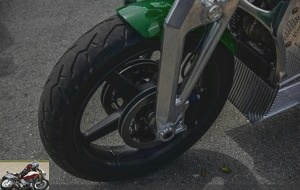 18 "BST rims are carbon fiber
18 "BST rims are carbon fiber
Up front, as before, is the double wishbone parallelogram fork, with tubular aluminum legs and a full direct-acting RaceTech damper adjustable in compression and rebound, offering 114mm of travel. The raised rear rests on an aluminum swingarm with a RaceTech Cantilever shock absorber, adjustable on two levels of compression and rebound, with a travel of 140 mm which is very important compared to the standards of cruisers. The very prone position of the shock absorber offers, in theory, a more progressive response of the rear suspension, despite the lack of connection. The wheelbase is 1.588 mm long.
 At the front, the parallelogram fork is supported by an adjustable RaceTech shock absorber.
At the front, the parallelogram fork is supported by an adjustable RaceTech shock absorber.
Like the Bomber, the Warhawk is fitted with the latest generation of brakes with nothing less than four Beringer Aeronal 230mm floating discs placed in pairs and bitten by Aerotec 4-piston radial calipers to stop the bike’s 247kg with the 14.2 liter tank. The weight distribution is 48/52% between the front and the rear. At the rear, there is another pair of 230mm Beringer discs with a 4-piston caliper. But why is there no ABS ?
As a single model, it was unnecessary to invest so much to develop such a system on the Warhawk, but we will have a full set of brakes with ABS on the Curtiss electric models when we start production..
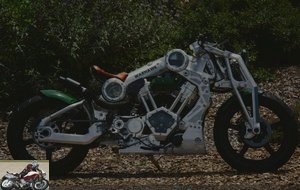 All braking is provided by Beringer, but without ABS
All braking is provided by Beringer, but without ABS
In the saddle
Although production of the Curtiss Warhawk started in May 2018, no one other than employees or customers has been allowed to fly one so far. So I had the chance to be one of the privileged few to be able to do it when I came to California, along the winding roads with their bends interspersed with fast sections that run from Carmel to Salinas, a few Only kilometers from the Laguna Seca circuit. It was there that I discovered that, once again, any production at the Alabama plant has improbable handling by Cruiser standards and positively urges you to drive hard. As always in such circumstances, I got too easily caught up in the game !
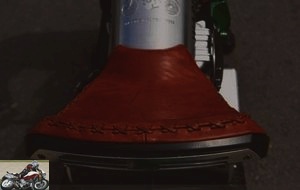 The saddle is much more comfortable than it seems at first glance
The saddle is much more comfortable than it seems at first glance
When one rides the Warhawk, one realizes that the riding position is subtly different from that of its Bomber cousin with a slightly higher stature. The 750mm height of the more comfortable minimalist saddle than it looks rises 13mm and the legs are a bit further back, offering a typical cafe racer stance that feels rational. The flat handlebars push you to lean forward slightly to catch the grips and the feet easily find their place on the footrests without these new high exhausts touching the inside of the legs (although they give off quite a bit of heat despite calorific band).
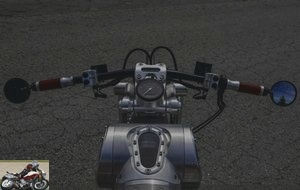 The very flat handlebars provide a slightly tilted forward position
The very flat handlebars provide a slightly tilted forward position
Test
The ignition of the X-Wedge engine is instantaneous, after turning the ignition key down to the level of the right knee and activating the tiny starter on the right stalk which seems disproportionately delicate for such a muscle bike. Just push the start button and the engine starts immediately on the first try, every time. But you have to be ready to feel the earth move under the thunder emitted by the silencers.
This easy starting to Big Twin standards is due to the fact that S&S equipped the engine with its Easy Start cams which reduce the compression at start up thanks to an innovative function. Each of the two exhaust cam lobes is equipped with a spring loaded compression release lobe on the heel of the cam, where the valve would normally be fully closed. This lobe keeps the valve slightly open at cranking speed, releasing some of the compression and helping the engine to run. Once it starts, the speed increases to 800 RPM and the lobe retracts by centrifugation, allowing the exhaust valve to close completely as part of the normal engine cycle. This then operates normally with full compression. Smart !
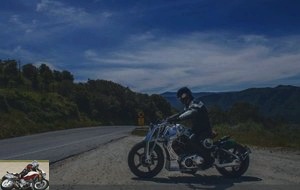 The X-Wedge receives an innovative ignition system that allows easy starting on every test.
The X-Wedge receives an innovative ignition system that allows easy starting on every test.
When that happens, the Warhawk’s engine comes to life with a meaty thunderclap from the exhaust, settling down to a revs of 900 rpm devoid of the rattling and clacking of some of the other American rocker-cooled V-Twins. air. Although S&S refuses to adapt anti-vibration balance shafts, the triple camshaft X-Wedge engine remains smooth enough for an air V-Twin, without excessive vibration despite its strength to provide more rigidity to the chassis. . Thanks to the fuel brought in by the Delphi electronic injection, it comes out cleanly from idle with a host of rumblings in a truly impressive acceleration. You simply open the accelerator on almost any gear and the Confederate takes off irresistibly, but with control. Engine mapping is ideal, without overly crisp grip response and wheelies are no problem thanks to the long wheelbase. This great acceleration is due to the enormous amount of torque available at almost all revs and which peaks at just 2,000 rpm, but remains plentiful throughout the range until the switch at 6,200 rpm. ‘it will never be necessary to reach.
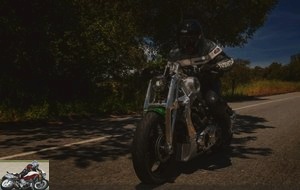 In motion, the escapement provides a very pleasant low tone
In motion, the escapement provides a very pleasant low tone
The best area of the X-Wedge is between 2,000 and 3,500 RPM, so despite Matt Chambers’ desire for more power at high revs, I found it best to shift gears. at around 4,000 rpm, as shown on the motorcycle’s only instrument, a round black field analog tachometer from Motogadget installed behind the steering column. This also includes a small LCD screen showing speed, fuel level with a red warning light, a green N for neutral and that’s it. This allows us to ride this very strong torque curve while keeping in mind that even at 3,000 rpm in fifth gear we are already at 160 km / h. And it takes very little time to get there thanks to the muscular reserves of the machine.
While the surprisingly light hydraulically operated Bandit clutch (surprisingly because of all the torque it has to handle) has little difficulty accelerating even after the tightest corner, it’s best to keep the revs low. above 2,000 rpm where the peak torque is to avoid transmission jerks. The torque curve almost forms a plateau from there up to 5,500 rpm, at which speed the 2,136 cc engine delivers all of its 156 horsepower..
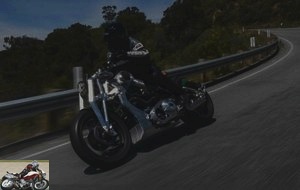 With 156 hp and 217 Nm of torque, the Twin delivers great sensations
With 156 hp and 217 Nm of torque, the Twin delivers great sensations
Shifting on the Curtiss Warhawk is smooth while still making it easy to find neutral when stationary. But with so much torque in reserve, two of these five gears are completely superfluous since you can start from the third without having to play too much on the clutch while the Curtiss can roll almost all the time on the last. report with impressive performance on almost all revs. Despite its size, it is an excellent motorcycle for moving in traffic, making good use of the S&S engine to emerge between cars and trucks while trying to make its way. While it is normal that one would expect this from such a large engine, the fact that this level of performance is achieved with such refinement and so little vibration is truly impressive..
The Pirelli Night Dragon front grip encourages you to maintain speed in the corners, especially since there is more ground clearance than on the Warhawk with the exhausts reassembled providing additional clearance. The large rear tire is mounted on an 8.5-inch BST carbon rim that is slightly wider than usual to distribute the rubber more, resulting in a flatter profile with a more progressive feel. You do not feel the Warhawk "fall" on the angle at the chord point when you reach the shoulder of the tire as is the case on some bikes with a similar rear. This is a mechanical set that performs much better than one would expect, especially in terms of handling..
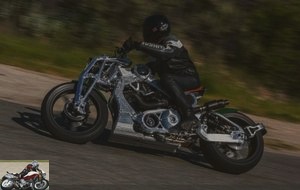 Despite the huge 240 rear tire, the Warhawk is very manoeuvrable.
Despite the huge 240 rear tire, the Warhawk is very manoeuvrable.
Cycle part
Overall, the bike is no wider than the massive Pirelli Night Dragon 240/45-VR18 rear tire which, despite its size, leaves a bike nimble and responsive. This is in part due to the reduced gyroscopic effect of the BST carbon front rim and the reduced size Beringer brake quartet that help accelerate the steering so there is no need to force downforce on the handlebars. to easily rock the Warhawk from side to side.
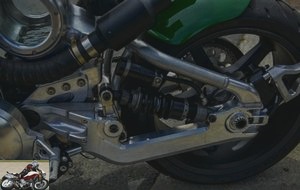 The RaceTech rear shock is also adjustable
The RaceTech rear shock is also adjustable
Despite the long wheelbase of 1,588mm and that big rear tire, the Warhawk is improbably light, although a bit lazy with that wheelbase and very conservative geometry with a 27.5 ° opening and 106mm trail. Even though you can’t grasp the backbone of the frame between your knees, you feel more or less in tune with the bike steering and handling quite efficiently. It’s super stable when braking downhill in the corners as the similar-type fork to John Britten’s favorite, here machined from aluminum to keep the unsprung weight low, continues to work to cushion the imperfections of the road, including on the corner. The RaceTech shocks were tuned to adjust damping for a rider of my weight and the Warhawk provided confidence in the ride. Ms. Curtiss would have approved.
Braking
The Beringer 230mm front floating disc quartet performs flawlessly and provides good feedback to stop the Curtiss at the high speeds it is capable of, as proven by customer Jim Hoegh by establishing a new speed record on his Confederate Hellcat on Lake Bonneville in 2014 by reaching 277.146 km / h in the APF-3000 class for motorcycles with conventional V-Twin engines over 2000 cc. To do this he had used the slightly less powerful X-Wedge engine than that of the last Warhawk, allowing the Birmingham engine manufacturer to produce the fastest big twin in the world, ahead of all Harley-Davidson and Indian have to. to offer. Again, Ms. Curtiss would have appreciated !
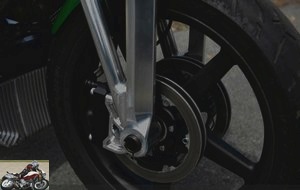 The Warhawk receives 4 Beringer Aeronal floating discs and Aerotec radial calipers at the front
The Warhawk receives 4 Beringer Aeronal floating discs and Aerotec radial calipers at the front
Conclusion
I believe this Curtiss Warhawk is the best petrol engine motorcycle I have ever made and have been producing it for almost 30 years. It seems like a fitting way to say goodbye as we turn the page to fully focus on our electric models. This Final Edition also echoes the fact that Glenn Curtiss invented the American V-Twin cruiser, although he later left it behind before taking a new direction with aviation. Well, we do the same, while staying on two-wheelers, but with electric propulsion. Either way, it’s a revelation and we can only hope to be successful even a little in our new direction, as it was with his. !
We couldn’t have said better.
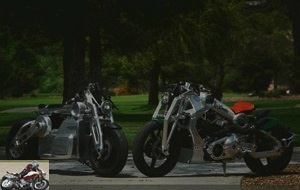 The Zeus proto electric and the thermal Warhawk
The Zeus proto electric and the thermal Warhawk
Strong points
- Look and finish
- Maneuverability
- Couple
- Braking
Weak points
- No ABS
- Look of the silencers
- Heat released by the exhaust
Curtiss P40 Warhawk Final Edition specification sheet
Related articles
-
BMW G650 Xmoto motorcycle test
650 cm3 of supermot BMW Xmoto 650 !! What is that thing ? Simple! A few years ago, the Bavarian firm thought it was going to go hunting on KTM lands, and…
-
Kawasaki Z H2 Supercharged motorcycle test
200 hp, 14 mkg at 8,500 rpm, 239 kg all full, 17,099 € Put some salt ! Fifteen days of driving with the Kawasaki Z H2? I say it bluntly, it takes less to…
-
Triumph Speed Triple R 1050 motorcycle test
A top-class Speed Triple From the luxury spokes from Ohlins for the suspensions, Brembo for the monobloc calipers and PVM for the forged wheels, the…
-
Royal Enfield Meteor 350 motorcycle test
Entry-level, extra class Air / oil single cylinder, 349 cm3, 20 hp and 27 Nm, 191 kg full made, from 4.099 euros Royal Enfield commemorates its 120th…
-
MV Agusta Superveloce 800 motorcycle test
Neo-retro in the right tempo 3 cylinders of 798 cm3, 148 hp, 88 Nm, 173 kg, 20,300 euros Concept bike adapted in an ultra exclusive limited series, the…
-
Benelli Imperiale 400 motorcycle test
EVO Classic 374 cc single cylinder, 21.1 hp, 29 Nm, 205 kg, 4,399 euros Benelli is the oldest existing brand in Italy. But we should no longer say…
-
The 1125 CR is the sporty roadster – more precisely the Cafe Racer – of the manufacturer of Wisconsin, directly resulting from the sporty 1125 R of the…
-
Royal Enfield Bullet 500 motorcycle test
Indian classic Virtually unchanged in 50 years, the Royal Enfield Bullet is the epitome of the motorcycle in its simplest form: two wheels, handlebars…
-
French watch or Gallic genius ? 128 hp Honda Moto2 engine, parallelogram suspension front axle, adjustable geometry, solid 7075 T6 aluminum chassis, 154…
-
Alternative American-style engineering 3 cylinders in W at 45 ° x 45 °, 2.472 cm3, 154 hp, 236 Nm, 268 kg California is teeming with talented tuners, all…
Hello,
I just read your essay and, as I am the proud owner of a small 250 CRF-L, I wanted to react a little.
As far as I’m concerned, the fifties are well spent, almost no experience outside asphalt (and some scares with an 800 GS (since sold) on tracks deemed "easy" such as the Col de la Finestre or the Assietta). And besides, I’m not a giant, far from it (1m69).
In short, as I still wanted to go and discover this beautiful region of Auvergne a little, I told myself that I needed a light machine that was easy to take along, so as not to be (too much) fear.
So I first tried a (real) enduro, namely an HM 250. There I was able to realize that being "small" is not so crippling. These bikes are certainly tall, but thin and light, which compensates, to put a foot on the ground it is enough to let slip. On the other hand, I don’t need a machine capable of climbing trees, the maintenance is complicated and in addition, it’s really too noisy for me. In short, after having hesitated with the Beta Alp, I fell back on the discreet CRF-L which, given my TT level "Triple Leek fourth dan" is largely sufficient (its limits are well beyond mine).
So, regarding your conclusions I would like to add a few nuances:
– The saddle height: Of course, it is high (less than an enduro), but it is very thin and "light". So that’s not really a problem. Mine has, in addition, a small luggage rack and a small Touratech saddlebag attached to it and I still manage to step over it easily to climb on it. And as the suspensions are quite flexible, it helps.
– Discomfort: It’s just a matter of habit. Personally I do not find it that uncomfortable (no more than an 800 GS for example).
– Commodos: Uh … Where’s the "problem"? Well, maybe the fact of having, beside, a CB 500 X like "GT", makes that I do not realize it.
– Positioning: For me it is quite clear, it’s a real little trail, with the qualities and faults inherent in this kind of machine. Able to play with the city, small roads and "easy" paths with gusto. A real little ride machine. She might even become a real little traveler but…
– Autonomy: There, I completely agree with your conclusions. 200 kms (and again, it depends on the use), it is really too tight (well, it must also be said that the CB X gives me bad habits with more than 500 kms in the tank). So much so that I head to put a larger tank (like Acerbis or other). On the other hand I am afraid of losing the gauge (or at least its calibration) in the operation. To have.
– Tires: They are not that bad as you might think. On dry asphalt they go very well (as long as you drive "normally"). On wet roads well … These are obviously not PR4s but being careful, it is as good as TKC-80s. Out of the asphalt they are largely good enough for my level. The problem is that they wear out quite quickly and the choice to replace them is not huge in these dimensions (moreover, they are often "typical" choices).
– The selection: I did not feel "harsh".
In the end, it does not make me want to change it, either for a pure and hard enduro, or for the more expensive, higher and heavier Rally model which has, for my advantage, only its tank of 10 liters.
Good to you.
Coolapix
Thank you for this long user feedback, which proves that everyone finds noon at their doorstep and that you saw in this nice CRF250L a little trail more than a light enduro machine, thus providing an answer to my questions! Regarding the gearbox, the test copy lacked kilometers (600) and I’m currently driving a Rally version with more mileage (2000), without encountering the same problem. As for the tires, they hold up roughly, but the attack is still lacking in feeling when entering the bend and it is astonishing on the part of Honda to have chosen a more than mixed TT mount. As for the autonomy, we agree: a little more would have allowed to enjoy it without a second thought, if it was the comfort, on which we disagree (well, not that of the rear suspension), but the saddle is still stiff. Finally, we get used to everything !
thank you for following us
Philippe
very nice little bike that has been eyeing me for a few years. To crack for new or a good cost on the coincoin.
Hello,
I went to try the beast yesterday at honda werther in Nice, I was delighted, I completely agree with the conclusions of coolapix and even with my 90 kg …. I will buy it ….. .